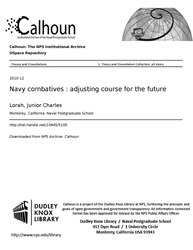File:Navy combatives - adjusting course for the future (IA navycombativesdj109455105).pdf

Original file (1,275 × 1,650 pixels, file size: 723 KB, MIME type: application/pdf, 114 pages)
Captions
Captions
Summary[edit]
| Navy combatives : adjusting course for the future
( |
||
|---|---|---|
| Author |
Lorah, Junior Charles |
|
| Title |
Navy combatives : adjusting course for the future |
|
| Publisher |
Monterey, California. Naval Postgraduate School |
|
| Description |
The purpose of this research is to identify if there is a need for combatives training in the United States Navy. Historically, there would not be a need for a Navy Self-Defense Program. However, the operating environment has changed. The mission of the Navy is changing. The battlefield, which has typically been largely a one-dimensional front led by the United States Army, requires a more dynamic, all-encompassing approach. Emerging oppositions, and increased military commitments on a global scale, expanded the roles of all service members. The most dramatic change is to the Navy Sailor. Servicemen, in particular Sailors, are being assigned to nontraditional tasks. Ten years ago this was not the case. However, with 9/11, the Navy's role has changed. The Navy has historically lacked in this type of training. Currently, limited training in self-defense is provided. The Navy has no proactive plan for the future. Hand-to-hand combat training for the Navy is completely overlooked. The Army Modern Combatives Program (MAC) and Marine Corps Martial Arts Program (MCMAP) were developed out of the need for a standardized system to train and develop warriors. The Air Force Combative Program (AFCP) was born from the MAC mold, recognizing a need to enhance fighting capabilities. On an international level, Israel and Russia developed programs for similar reasons. MCMAP is the recommended program to introduce combatives to the U.S. Navy. From there, the U.S. Navy can develop a program that is tailored to the different job specialties available. Core facilities are available in key Navy ports throughout the world that can provide a training ground for Navy combatives. From a cost-benefit look at combatives, this thesis argues that the benefits outweigh the costs. Injuries will occur in combatives, but the benefits to teaching combatives outweigh these costs. Providing a self-defense program helps develop and enhance the overall skills of a Sailor. Additionally, self-defense training might help a Sailor recognize weaknesses and vulnerabilities. Most importantly, combatives enhances the qualities of the Navy Core Values in every Sailor. Subjects: Martial arts; Self-defense; Training |
|
| Language | English | |
| Publication date | December 2010 | |
| Current location |
IA Collections: navalpostgraduateschoollibrary; fedlink |
|
| Accession number |
navycombativesdj109455105 |
|
| Source | ||
| Permission (Reusing this file) |
This publication is a work of the U.S. Government as defined in Title 17, United States Code, Section 101. Copyright protection is not available for this work in the United States. | |
Licensing[edit]
| Public domainPublic domainfalsefalse |
This work is in the public domain in the United States because it is a work prepared by an officer or employee of the United States Government as part of that person’s official duties under the terms of Title 17, Chapter 1, Section 105 of the US Code.
Note: This only applies to original works of the Federal Government and not to the work of any individual U.S. state, territory, commonwealth, county, municipality, or any other subdivision. This template also does not apply to postage stamp designs published by the United States Postal Service since 1978. (See § 313.6(C)(1) of Compendium of U.S. Copyright Office Practices). It also does not apply to certain US coins; see The US Mint Terms of Use.
|
 | |
| This file has been identified as being free of known restrictions under copyright law, including all related and neighboring rights. | ||
https://creativecommons.org/publicdomain/mark/1.0/PDMCreative Commons Public Domain Mark 1.0falsefalse
File history
Click on a date/time to view the file as it appeared at that time.
| Date/Time | Thumbnail | Dimensions | User | Comment | |
|---|---|---|---|---|---|
| current | 06:15, 23 July 2020 |  | 1,275 × 1,650, 114 pages (723 KB) | Fæ (talk | contribs) | FEDLINK - United States Federal Collection navycombativesdj109455105 (User talk:Fæ/IA books#Fork8) (batch 1993-2020 #22832) |
You cannot overwrite this file.
File usage on Commons
The following page uses this file:
Metadata
This file contains additional information such as Exif metadata which may have been added by the digital camera, scanner, or software program used to create or digitize it. If the file has been modified from its original state, some details such as the timestamp may not fully reflect those of the original file. The timestamp is only as accurate as the clock in the camera, and it may be completely wrong.
| Short title | Navy combatives : adjusting course for the future |
|---|---|
| Author | Lorah, Junior Charles |
| Software used | Lorah, Junior Charles |
| Conversion program | Acrobat Distiller 9.4.0 (Windows) |
| Encrypted | no |
| Page size | 612 x 792 pts (letter) |
| Version of PDF format | 1.4 |

